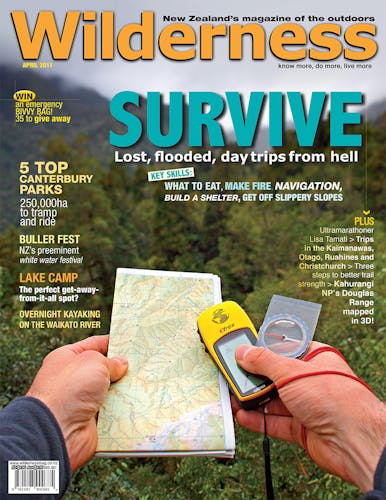Letter of the month
Dore Pass for experienced trampers only
In reply to Alan Anson’s letter (Letter of the Month, March 2011) about Dore Pass, in early January 2010 I undertook a long solo trip down south. I walked from Mavora Lakes to the Routeburn then hitched along the Eglington Valley, crossing the river and walked over Dore Pass.
The Eglington was thigh deep to cross and track signs are small to keep road tourists from attempting to cross the river to get to the pass. Orange triangular markers up the track to Dore Pass changed to waratahs above the bushline and were lying in various angles from off vertical to horizontal. Gullies east of the divide had ice bridges of dubious strength across side streams that had to be traversed as the slopes above were covered in scree – it was the most scary part of my solo summer adventures.
I had fair weather, and there was no snow on the western side of the pass. DOC advises that the traverse north from the pass can be confusing as the waratahs are hard to see and veer slightly uphill before descending a spur to Glade House. DOC does not encourage parties to go this way unless well experienced. The area is poorly marked for a bad weather trip, but in fair weather there is excellent camping high above the bushline on the western side of the pass that provides great sunsets while Glade House shivers in the shade below.
– Jenny Cossey, Wellington
I would like to add to Brett Smith’s advice on how to maximise the life of a waterproof breathable jacket (Letter of the Month, February 2011).
I have been involved in manufacturing outdoor products in New Zealand for over 30 years. Our suggestions to get the most out of your waterproof breathable jacket are as follows:
- Reduce the contamination on your garment as much as possible by preventing your bare skin from touching the inside surface of your jacket. You can do this by wearing long sleeve garments, high collars or bandana’s around your neck. The dirt that destroys your waterproof breathable comes from the wearer’s skin, not the environment. Wear a white shirt for a day and then check the grime around the collar. It is this contamination that eats away at the waterproof breathable laminates and coatings. Reducing the contamination reduces the need to wash your jacket which in turn maximises the life of the initial water repellent factory finish.
- If the jacket has dirt on the outside – sponge this off with warm soapy water – and rinse the area with clean warm water. Water easily attaches to dirt so you don’t want dirt on the outside of your jacket.
- Never dry clean your waterproof jacket as it strips off all the factory finish water repellency. You will never be able to replace it fully once it has gone.
- When you need to replenish your water repellent finish chose a solvent based fluoropolymer – it is more effective and more durable. Be wary of water repellent products that don’t clearly define what process they are using in their marketing.
- Follow the manufacturer’s instructions carefully when applying water repellent.
– David Ellis, Earth Sea Sky, Christchurch
Heaphy didn’t walk the Heaphy
I love Wilderness, and none more so than the recent December 2010 issue with its exciting coverage of the nine Great Walks. However, I was a little disturbed to find what I think is an inaccuracy in the Heaphy chapter, stating that Charles Heaphy was the first European to use this track. My reading leads me to believe he did not actually traverse the track; rather it was named after him in his honour.
– Neville Salisbury, email
Walking and cycling don’t mix
As walkers we are getting concerned at the way all our wonderful tracks are being taken over by the cycling fraternity.
Out there, on four day walks and having to put up with the rushing by of cyclists isn’t on. We love the wilderness, the birds and the silence. What do cyclists see? Nothing, they just rush by looking at the watch. They don’t even see our beautiful countryside.
We have been tramping since 1988 and at 76 years we are still hoping to do more.
Leave our tracks alone.
Who is out there looking after the walking groups? No-one!
– Betty Stockman, Taupo
Wardens Over the Top?
The special feature on huts (March, 2011) did a great job of covering New Zealand’s culture of tramping huts. I expect the need for refuge in the wild Tararuas will be permanent, but I hope the super-keen younger Glovers’ preference for huts versus tents is only temporary. Something else I hope is only temporary is the over-zealous behaviour of hut wardens in Tongariro National Park. I don’t share Josh Gale’s enthusiasm (Escape to the Hills, p36) for the antics of the warden trainer featured because I have encountered the behaviour firsthand.
When did it become the case that making your lunch inside a hut required a hut booking or hut fees, or else constituted a ‘trick’?
Citizens of New Zealand are co-owners of huts such as Waihohonu, which was featured. Whether we believe its high standard of facilities is necessary or more an imposition on us that has led to over-the-top wardening, the New Zealand hut culture is stronger in us than in the misplaced rule-lovers doing the warden duties. Is this really a ‘model for the rest of the country’?
Thankfully the overwhelming majority of the administrators do a much better job than this. The law-enforcement attitudes are better channeled into stopping or punishing motorbike riders and others who ruin the land or our experience in it.
– Matt Johnston, Auckland






